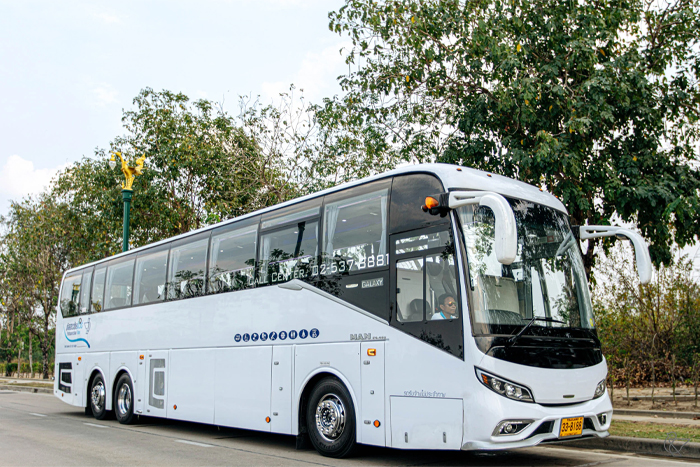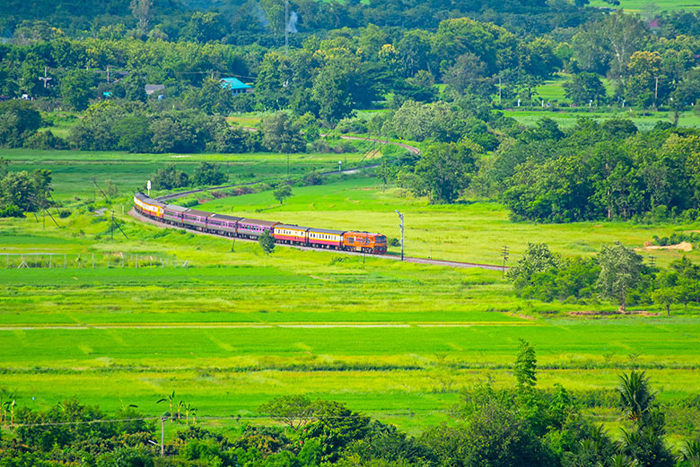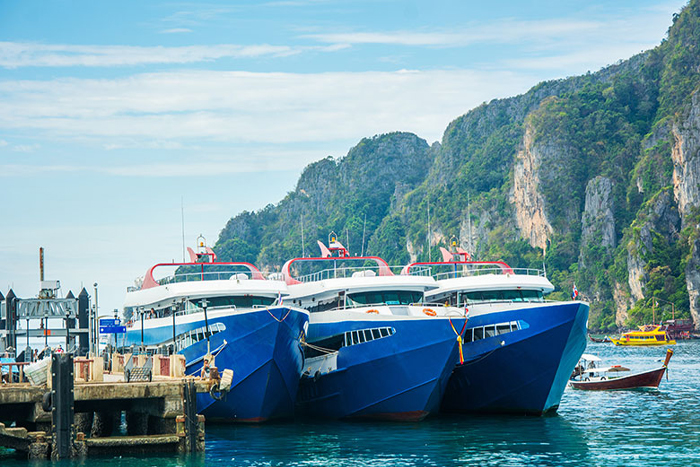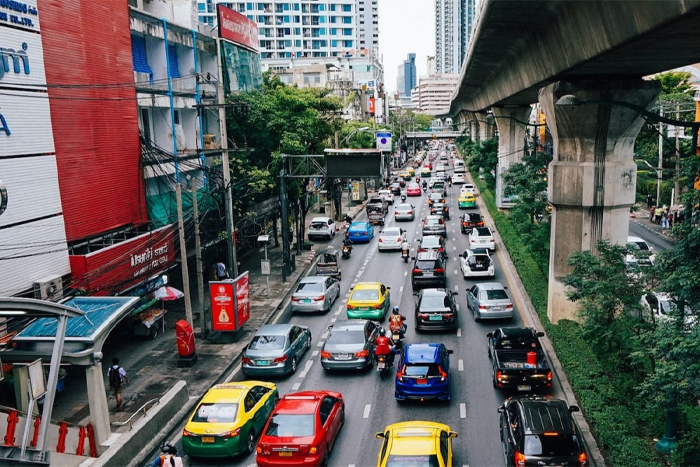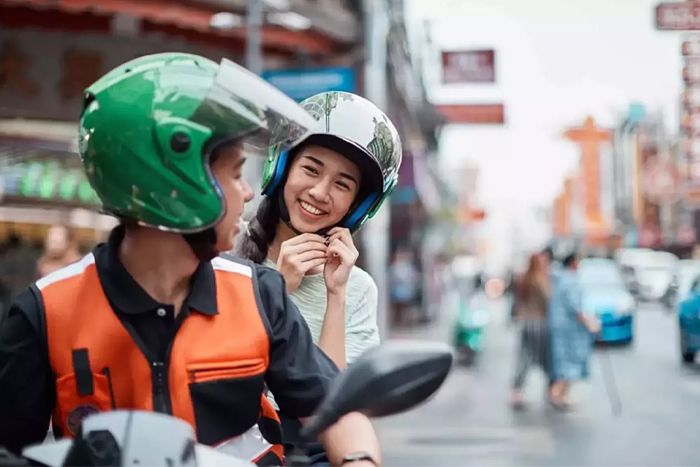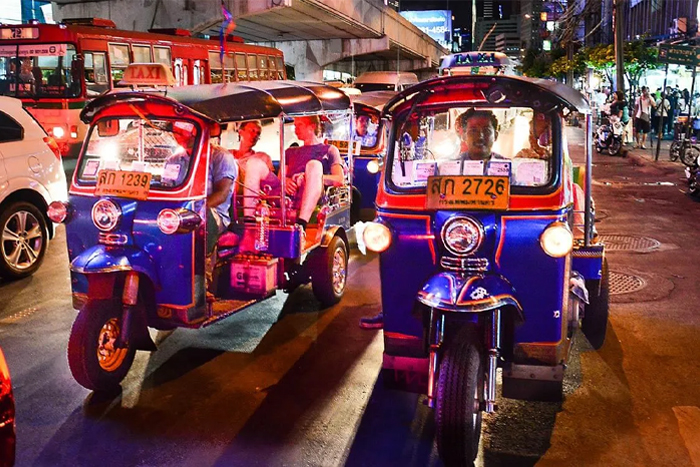Thailand, with its diverse landscapes, vibrant cities, and paradise-like beaches, is a destination that attracts millions of travelers each year. To fully enjoy this fascinating country, it's essential to understand the various transportation options available. How to get around in Thailand: public or private transport? This question is crucial for anyone planning to explore the land of smiles. In this comprehensive guide, we'll explore the various modes of transport available across Thailand, helping you make informed decisions for your journey. Whether you're a backpacker on a shoestring budget, a family seeking convenience, or a luxury traveler looking for comfort, we'll cover options to suit every need. Let's embark on a journey through Thailand transportation landscape, ensuring you can navigate this beautiful country with ease and confidence.
The diversity of Thailand transportation is impressive. Getting around in Thailand is particularly easy, partly thanks to the warm welcome and famous smile of the locals. Whether by air, land, or sea, the options are numerous. Travelers can choose from various solutions, ranging from picturesque tuk-tuks to private transport services, not to mention low-cost airlines. This multitude of choices allows everyone to find the mode of transportation that suits them best.
I. Thailand transportation: Which public transport to choose to travel?
1. By plane
How to get around in Thailand? If you plan to travel between different regions of Thailand, flying is the ideal choice to save time during your trip. Thailand offers a well-developed air network, with medium-sized airports serving most of the country's major cities. This infrastructure allows for good connectivity through domestic flights.
Bangkok, the capital, plays a central role in this network with its two airports. The newer Suvarnabhumi is primarily dedicated to international flights. The older airport, Don Mueang, focuses on domestic flights and hosts low-cost carriers like Air Asia and Nok Air. Thanks to this air network and the various airlines operating in the country, it's possible to reach most Thai destinations by plane. Your choice of route and airline will depend on your final destination.
2. By bus
Traveling by bus offers an economical and efficient Thailand public transportation for exploring the kingdom. The Thai road network, with its many well-maintained expressways, allows buses to easily circulate between major cities and the most remote villages. The bus transportation system in Thailand is distinguished by its diversity and extent. Private companies offer long-distance connections, not only within the country but also to neighboring countries like Laos, Cambodia, and Myanmar. These services offer several categories, from luxurious VIP buses to more affordable second-class buses, including Gold buses, Sleeping buses, and first-class buses. Comfort, space, and service quality vary depending on the chosen category.
For those on a tight budget, Thailand public transportation remain the least expensive option, although less comfortable and with frequent stops. On the other hand, high-end buses ensure fast and comfortable journeys thanks to the developed highway network.
In Bangkok, three main bus terminals serve different regions of the country:
1. Mo Chit (Northern Bus Terminal): for the north, notably Chiang Mai and the Isaan region.
2. Ekamai (Eastern Bus Terminal): for the east of the country.
3. Sai Tai Mai (Southern Bus Terminal): for the south, including Kanchanaburi, Phuket, Krabi, and Surat Thani.
It's crucial to check the departure terminal corresponding to your destination before embarking on your journey. This organization allows for efficient coverage of the entire Thai territory by bus.
3. By train
How to get around in Thailand? Traveling by train in Thailand offers a unique experience, particularly suited to travelers with time to spare and eager to immerse themselves in the country's beauty. The Thai railway network, although aging, crosses the kingdom from north to south and east to northeast, connecting Bangkok to over 30 destinations, from big cities to picturesque small villages. Thai trains offer three travel classes, each providing a distinct level of comfort. First class, air-conditioned and spacious, ensures a comfortable journey. Second and third classes, less luxurious, allow for a more authentic immersion in local culture. Although the journeys are relatively slow - for example, the Bangkok-Chiang Mai trip takes about 12 hours - this slowness becomes an asset for landscape enthusiasts. Passengers can leisurely contemplate the diversity of Thai panoramas, from verdant rice fields to lush jungles and majestic mountains.
4. By boat and ferry
Boats and ferries play a crucial role in Thailand transportation system, offering a picturesque and often essential means of discovering the country. These vessels are vital for accessing the many paradise islands that dot the coasts of the Andaman Sea and the Gulf of Thailand. Options vary considerably, ranging from economical but basic local ferries to more comfortable fast catamarans, suitable for hurried tourists. In coastal and riverside cities, water taxis and traditional long-tail boats offer a charming alternative to land transport, allowing you to avoid traffic jams while offering spectacular views. In Bangkok, river buses on the Chao Phraya River and canals (klongs) are not only an efficient means of transport but also a unique way to observe daily life along the waterfront. For travelers seeking a more immersive experience, river cruises are available, particularly on the Mekong, offering a novel perspective on rural landscapes and Thai culture.
II. Thailand transportation: Which private transport to choose to travel?
1. By taxi
axis are an affordable and ubiquitous Thailand transportation option, particularly in the central and northern regions of the country. Their less prominent presence in the south doesn't prevent travelers from benefiting from ingenious alternatives. Among these, the songthaew stands out as a unique and economical collective transport solution.
The songthaew, whose name literally means "two rows" in Thai, is a hybrid vehicle born from the creative adaptation of a pickup truck into a rudimentary minibus. Its configuration is simple but effective: two wooden benches are fixed on either side of the rear platform, allowing several passengers to be accommodated. This arrangement not only promotes increased transport capacity but also significantly reduces the cost per person compared to conventional taxis. This mode of Thailand transportation, deeply rooted in local culture, offers travelers an authentic immersion into Thai daily life. Although less comfortable than a classic taxi, the songthaew compensates with its picturesque charm and efficiency, representing a choice option for those looking to optimize their budget while experiencing something typically Thai.
2. By motorbike taxi
How to get around in Thailand? Getting around in Thailand offers tourists a variety of options, with motorcycle taxis being a popular choice for quick and economical transport, especially in large cities like Bangkok where traffic jams are common. These motorcycle taxis are easily identifiable by their drivers wearing numbered colored vests and can typically be found on street corners and near popular destinations. While they're effective for short distances, it's crucial to prioritize safety when using this mode of transportation. Always negotiate the price before starting your journey, ask for a helmet if one isn't provided, and avoid using motorcycle taxis for long trips or when carrying bulky luggage. Despite their convenience in navigating through congested urban areas, it's important to remember that motorcycle taxis can pose risks, particularly for travelers who aren't accustomed to the dense and sometimes chaotic traffic patterns of Thai cities.
3. By tuk-tuk
One of the most iconic sights in Thai cities, and a must-try for many visitors, is the tuk-tuk. These motorized tricycles are ubiquitous on Thai streets and have become synonymous with transportation in Southeast Asia. Tuk-tuks offer a unique solution for short urban trips, allowing you to navigate through congested areas with surprising agility.
Before embarking on a tuk-tuk ride, it's essential to negotiate the fare - a practice that's not just about saving money, but also part of the local culture. While prices can vary, tuk-tuk rides generally remain affordable, making them an attractive option for budget-conscious travelers.
Opting for a tuk-tuk goes beyond mere conveyance; it's an immersion into the vibrant pulse of Thai life. This Thailand transportation is particularly striking in a metropolis like Bangkok, where the contrast between modern skyscrapers and traditional street life creates a captivating urban tapestry. As you weave through the capital's often paralyzed traffic, you'll experience a journey that's as thrilling as it is efficient.
4. Vehicle rental
How to get around in Thailand? Vehicle rental is an increasingly popular choice for tourists seeking to explore Thailand on their own terms, offering unparalleled flexibility and freedom to discover the country's diverse landscapes and hidden gems. This option allows travelers to create their own itineraries, venture off the beaten path, and immerse themselves in the local culture at their own pace. In Thailand, visitors have access to a wide array of vehicle rental options, each suited to different travel styles, budgets, and destinations.
- Scooters and motorcycles are very popular, offering great flexibility for navigating crowded cities and visiting tourist sites. They're ideal for short trips and provide an exhilarating way to experience Thailand's bustling streets and scenic routes. However, they require an international license and increased caution due to sometimes chaotic traffic conditions. While cost-effective, riders should prioritize safety and be comfortable with local driving norms.
- Cars are ideal for long trips and exploring rural regions, with many rental agencies available in major cities and airports. They offer more safety and comfort, especially for families or groups, and are well-suited for extended journeys across Thailand's diverse landscapes. Cars provide air conditioning and ample storage space, which can be crucial in Thailand's tropical climate. However, they can be less practical in congested urban areas where parking might be scarce and expensive.
- Bicycles represent an eco-friendly and economical alternative, perfect for discovering cities at a slower pace or exploring the surrounding countryside. They're great for short distances, especially in areas with dedicated bike lanes or in historical parks. Cycling allows for an intimate experience with local life and culture, though riders should be mindful of the heat and ensure they stay hydrated. While limited in range compared to motorized options, bicycles offer a unique and healthy way to see Thailand.
Each rental option has its advantages and considerations. Tourists should choose based on their itinerary, comfort level with local traffic, and desired travel experience. Regardless of the choice, it's essential to understand rental agreements, insurance coverage, and local traffic laws to ensure a safe and enjoyable journey through Thailand.
III. Tips for choosing the best mode of transportation
1. Some apps for booking suitable transportation in Thailand
Taxi and motorcycle taxi booking apps have become very popular in Thailand, greatly facilitating travel for tourists and locals alike. Here's a list of the most commonly used apps in Thailand:
Grab: This is the most popular app in Southeast Asia, offering taxi, motorcycle taxi, and even food delivery services.
Bolt: Formerly known as Taxify, this app is also widely used in Thailand.
inDriver: An app that allows passengers to negotiate fares with drivers.
LINE Man: An extension of the LINE messaging app, very popular in Thailand, which offers transport services.
Gojek: Although initially Indonesian, this app has expanded to Thailand and offers motorcycle taxi services.
Note: To use transport apps in Thailand, a local SIM card with internet is recommended. Most apps, like Grab, offer messaging with automatic English translation, facilitating communication with drivers. Note that these services are mainly available in large cities and tourist areas, where many drivers speak some English. Their use may be limited in more remote regions.
Note that app-based transport services are primarily available in major cities like Bangkok, Chiang Mai, or Phuket. If you're visiting more rural regions or less touristy islands, these apps might not be accessible. In this case, it's advisable to:
Use songthaews (converted pickup trucks for passenger transport)
Use local tuk-tuks
Rent a scooter (if you're comfortable driving)
Ask your accommodation to call a local taxi
Use local bus services
Remember to negotiate the fare before getting in, especially for tuk-tuks and taxis, to avoid higher than normal travel costs. In very touristy areas, stay vigilant against potential scams.
2. Tips for choosing mode of transport to get around Thailand
Navigating Thailand's diverse landscapes and bustling cities can be an adventure in itself. With options ranging from traditional tuk-tuks to modern metro systems, choosing the right mode of transport can significantly impact your Thai experience. Here are some tips for choosing the right mode of Thailand transportation as a visitor:
- For long distances between cities, prioritize buses, trains, or domestic flights.
- In the city, opt for taxis, tuk-tuks, or public transport.
- Buses and trains are economical for long journeys.
- Tuk-tuks and songthaews are affordable for short distances.
- For more comfort on long distances, choose train or plane.
- In the city, air-conditioned taxis are more comfortable than tuk-tuks.
- Renting a scooter offers great freedom, but check your insurance.
- Taxis and tuk-tuks allow on-demand travel.
- In large cities, favor official taxis or transport apps.
- Be cautious if renting a scooter, especially in high-traffic areas.
- On islands, scooters are practical.
- In Bangkok, the metro and BTS (Skytrain) are efficient for avoiding traffic jams.
- During the rainy season, covered transport is preferable.
Note: To avoid scams when traveling in Thailand, it's important to take certain precautions. Always negotiate the price in advance, especially for tuk-tuks and taxis. In taxis, insist that the meter be turned on and look for another vehicle if the driver refuses. Be wary of offers for "free" tours that often lead to expensive shops. Check your change carefully, especially when paying with large bills. In big cities, use reliable transport apps like Grab to ensure transparent pricing. Buy your bus and train tickets from official counters or on operators' websites. Always keep your luggage within reach, especially on public transport. Research typical fares to avoid overpaying. Learn a few Thai phrases to communicate more easily. Finally, trust your intuition: if a situation seems suspicious or dangerous, don't hesitate to seek an alternative.
Traveling in Thailand offers a multitude of options, each with its advantages and disadvantages. Whether you opt for economical and immersive public transport or the convenience of private transport to get around in Thailand, the key is to choose what best suits your travel style, budget, and destinations. Don't hesitate to combine different modes of transport during your stay to make the most of everything Thailand has to offer. With good planning and an open mind, your travels in Thailand will become an integral and memorable part of your adventure in the Land of Smiles.
To
get around in Thailand easily without any difficulties abroad, contact Autour Asia,
Thailand Travel Agency, to plan your stay according to your preferences.
Is it easy to drive in Thailand?
Driving in Thailand can be challenging for foreigners. The challenges include driving on the left, heavy traffic in big cities, different traffic rules, and sometimes unclear signage. Local drivers may exhibit unexpected behaviors, and road conditions vary. The language barrier and the need for an international driver's license add to the difficulty. Many foreigners therefore prefer to use other means of transport, at least initially, to adapt to the Thai road environment.
How to get around Thailand with family?
Getting around Thailand with family offers various suitable options. In big cities, taxis and transport apps are convenient; make sure child seats are available. Car rental is ideal for exploring freely, especially outside urban centers. For long journeys, trains offer comfort and sleeper berths. Public transport like the metro in Bangkok is fast and economical. To visit the islands, opt for boats and ferries, checking safety standards. Plan ahead, schedule frequent breaks, and bring entertainment for children. Flexibility is key, as delays are common. Choose the mode of transport according to your destination, budget, and desired comfort for your family.


